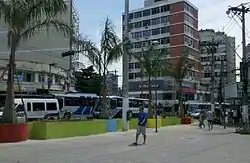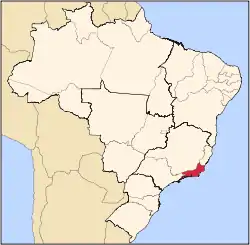São Gonçalo, Rio de Janeiro
São Gonçalo (Portuguese pronunciation: [sɐ̃w ɡõˈsalu]) is a municipality located in the Brazilian state of Rio de Janeiro. It is on northeastern Guanabara Bay in the Rio de Janeiro Metropolitan Area.
São Gonçalo | |
|---|---|
| Município do São Gonçalo | |
 Downtown | |
 Flag  Seal | |
| Nickname(s): Manchester Fluminense | |
 Localization in Rio de Janeiro | |
 São Gonçalo Localization in Brazil | |
| Coordinates: 22°49′37″S 43°03′14″W | |
| Country | |
| Region | Southeast |
| State | |
| City Established | 22 September 1890 |
| Government | |
| • Type | Mayor-council |
| • Body | Prefeitura de São Gonçalo |
| • Mayor | Capitão Nelson ( Avante) |
| Area | |
| • Total | 249.142 km2 (96.194 sq mi) |
| Elevation | 19 m (62 ft) |
| Population (2020 [1]) | |
| • Total | 1,091,737 |
| • Density | 4,400/km2 (11,000/sq mi) |
| Demonym(s) | gonçalense |
| Time zone | UTC−3 (BRT) |
| • Summer (DST) | UTC−2 (BRST) |
| Area code(s) | +55 21 |
It is located at 22° 49′ 37″ S, 43° 3′ 14″ W at an altitude of 19 metres (62 feet) above sea level.
Location
The population of São Gonçalo was 1,091,737 in 2020, and its area is 249 square kilometres (96 square miles).[2]
It is the second most populous city of the state, after the capital Rio de Janeiro city. Until recently it was the third largest, when Mesquita was split off as its own city from Nova Iguaçu.
The municipality contains 4% of the 1,936 hectares (4,780 acres) Guanabara Ecological Station, created in 2006.[3] It contains part of the Central Rio de Janeiro Atlantic Forest Mosaic of conservation units, created in 2006.[4]
Climate
The type of climate of São Gonçalo is Atlantic tropical, with rainy summers and relatively dry winters. Temperatures vary throughout the year on and can have a maximum up to 40 °C (104 °F) in summer, and a minimum close to 10 °C (50 °F) during winter. Generally, temperatures range between the maximum of 25 to 35 °C (77 to 95 °F) and minimum 14 to 24 °C (57 to 75 °F). But for the most part of the year, i.e. from May to October, the temperature is milder because the climate is drier and less hot.
Demography
| Year | Population |
|---|---|
| 1991 | 779,832 |
| 1996 | 831,467 |
| 2000 | 891,119 |
| 2007 | 960,631 |
| 2012 | 1,016,128 |
| 2020 | 1,091,737 |
São Gonçalo has a high index of population growth. The city has an estimated population of 1,091,737 (2020 estimate). According to the 2012 Census, the racial makeup of São Gonçalo includes: Whites (22.7%), Brown (54.1%), black or African (20.2%), two or more races (3%) and Asian (0.02%). Non-Brazilian population by any race was 3.5% (Paraguayan 2%, Bolivian 1%, Chinese 0.5%), a high index compared to cities in Brazil. According to the same Census, São Gonçalo has a high index of poverty. 31.5% of the population were living in the line of poverty in 2012, down from the 81% in 1990. People considered "Class A" were just 4.7%.
Education
The Rio de Janeiro State Teachers Training College (FFP-UERJ)stands out in the city. It is the largest teachers' college in Rio de Janeiro state offering advanced training of senior staff. The campus offers undergraduate courses in Biological Sciences, History, Geography, Letters: Portuguese / Literatures, Letters: Portuguese / English, Mathematics and Pedagogy.More graduates from FFP pass state tests than any other teaching institution in Brazil. Its importance is magnified when one analyzes what an advanced training pole of senior staff from the UERJ is. Its students are mostly residents from Sao Goncalo, but many come from Niterói, Rio de Janeiro, Itaboraí, and municipalities of the Baixada Fluminense region, among others. For many years, students of this campus demanding the implementation of a bus intercampi free to link to the Saint Mary UERJ Maracanã.
The Polo Open University of Brazil has courses in the Consortium of Universities CEDERJ UFF (Computer Science), UFRJ (Chemistry) and UFRRJ (Administration and Tourism).

Health
São Gonçalo has the following hospitals: Hospital Estadual Alberto Torres; Eye Hospital Niteroi; Hospital Luiz Palmier; Hospital Adam Pereira Nunes; Barone Hospital de Medeiros; Silveira Hospital Infantil Darcy Vargas, Hospital Pads, Hospital Santa Maria.
Garbage collection crisis
São Gonçalo suffers constantly from poor garbage collection services, and it is not uncommon for litter to accumulate on the streets. In December 2008, workers responsible for cleaning the streets went on strike, severely compromising public sanitation.[5] In January 2011, garbage collection ceased for more than a week in some parts of the city.[6] Now the problem is solved.
Notable people
- Zélio Fernandino de Moraes, founder of the Umbanda Branca religious sect.[7]
- Vinícius Júnior, a professional footballer currently playing for Real Madrid
- Helton Arruda, goalkeeper
- Marcelo Freixo, Brazilian politician, broadcaster and professor
See also
References
- IBGE 2020
- IBGE – efault.php
- ESEC da Guanabara (in Portuguese), ISA: Instituto Socioambiental, retrieved 5 October 2016
- Costa, Cláudia; Lamas, Ivana; Fernandes, Rosan (December 2010), Planejamento Estratégico do Mosaico Central Fluminense (PDF) (in Portuguese), Reserva da Biosfera da Mata Atlântica, p. 13, retrieved 2 October 2016
- "Greve de garis espalha mais de 800 toneladas de lixo pelas ruas de São Gonçalo". Archived from the original on 11 July 2011. Retrieved 24 February 2011.
- "Moradores de São Gonçalo ainda sofrem com falta de coleta de lixo". Archived from the original on 6 July 2011. Retrieved 24 February 2011.
- Saidenberg, Theresa. "Como surgiu a Umbanda em nosso país: 70° aniversário de uma religião brasileira." Revista Planeta, São Paulo, N. 75, December 1978. p. 34-35.and
External links
 Media related to São Gonçalo at Wikimedia Commons
Media related to São Gonçalo at Wikimedia Commons
